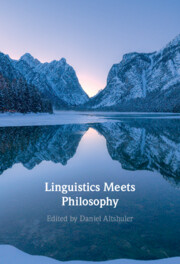Book contents
- Linguistics Meets Philosophy
- Linguistics Meets Philosophy
- Copyright page
- Contents
- Figures
- Tables
- Contributors
- Linguistics Meets Philosophy: A Historical Preface
- Introduction
- Part I Reporting and Ascribing
- Part II Describing and Referring
- 3 Referential and Attributive Descriptions
- 4 On Definite Descriptions: Can Familiarity And Uniqueness Be Distinguished?
- Part III Narrating and Structuring
- Part IV Locating and Inferring
- Part V Typologizing and Ontologizing
- Part VI Determining and Questioning
- Part VII Arguing and Rejecting
- Part VIII Implying and (Pre)supposing
- Index
- References
4 - On Definite Descriptions: Can Familiarity And Uniqueness Be Distinguished?
from Part II - Describing and Referring
Published online by Cambridge University Press: 06 October 2022
- Linguistics Meets Philosophy
- Linguistics Meets Philosophy
- Copyright page
- Contents
- Figures
- Tables
- Contributors
- Linguistics Meets Philosophy: A Historical Preface
- Introduction
- Part I Reporting and Ascribing
- Part II Describing and Referring
- 3 Referential and Attributive Descriptions
- 4 On Definite Descriptions: Can Familiarity And Uniqueness Be Distinguished?
- Part III Narrating and Structuring
- Part IV Locating and Inferring
- Part V Typologizing and Ontologizing
- Part VI Determining and Questioning
- Part VII Arguing and Rejecting
- Part VIII Implying and (Pre)supposing
- Index
- References
Summary
Definite descriptions are an area where linguistics and philosophy have been intimately intertwined as long as they have been acquainted. But are we past all that now, in the modern era, as work on definite descriptions becomes less focussed on English, and more cross-linguistic? This chapter highlights one great unresolved issue in the theory of definite descriptions that persists even in this modern era of crosslinguistic comparison, a foundational (hence philosophical) one, pitting dynamic semantics against situation semantics. A prominent synthesis of these competing (though compatible) frameworks says that both are needed, for “strong” and “weak” articles, respectively. The strong vs. weak distinction has served as inspiration for much recent work on the crosslinguistic semantics of definiteness. While this new development has led to a much richer and more well-rounded picture of definiteness as a phenomenon, the predictions of the two analyses overlap too much, leading to spurious debate when fieldworkers go to analyze a new language. The chapter aims to clarify what is at stake empirically in the choice among analyses, and advocates for continued philosophical reflection as we operationalize our methods of discovery.
Keywords
- Type
- Chapter
- Information
- Linguistics Meets Philosophy , pp. 109 - 136Publisher: Cambridge University PressPrint publication year: 2022
References
- 1
- Cited by

